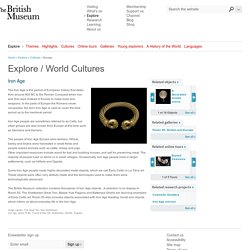

www.english-heritage.org.uk/content/imported-docs/education/hl38traw.pdf. History : British History Timeline. Iron Age and Celtic Coins for Sale. The coins. The ritual site at Hallaton in Leicestershire has produced 5,296 Iron Age and Roman coins.

Most were locally-made inscribed Iron Age coins, issued in about AD 20/30-50. These numbers mean that almost 10 percent of all known surviving British Iron Age coins were found at Hallaton. The true significance of this find, however, stems from the fact that many of these coins were recovered by archaeologists, during excavation, which allows us to relate them to the other activities at the site. At least 14 coin hoards were buried in the entranceway of the enclosure ditch which dominated the site. Another hoard was buried with the Roman helmet. 2011-10-27_IronAgeCoinHoard_exWeb.pdf. Snettisham Iron Age hoards. Torcs are large ornaments made from precious metals or bronze, worn around the neck, and are found across Britain and Europe during the Iron Age.

More torcs have been discovered in East Anglia than any other region, with a particular focus in northwest Norfolk. The majority of torcs are found in hoards – groups of artefacts placed together in the ground. Hoards are found placed in containers such as bags or pots, or carefully arranged in the ground. Iron age house reconstruction - Virtual archaeology. Daily life in Iron Age Britain. Iron Age People. Iron Age. The Iron Age is the period of European history that dates from around 800 BC to the Roman Conquest when iron was first used instead of bronze to make tools and weapons.

In the parts of Europe the Romans never conquered, the term Iron Age is used to cover the time period up to the medieval period. Iron Age people are sometimes referred to as Celts, but other groups are also known from Europe at this time such as Germans and Iberians. The people of Iron Age Europe were farmers. Wheat, barley and beans were harvested in small fields and people reared animals such as cattle, sheep and pigs. Ulster Museum - National Museums Northern Ireland. Lincs to the Past. War and art in Iron Age Britain.